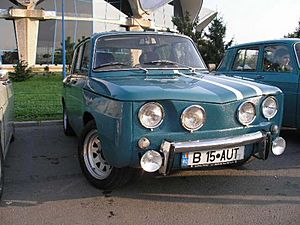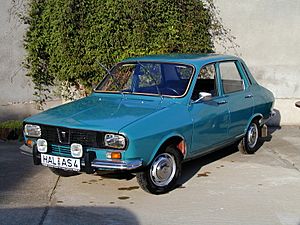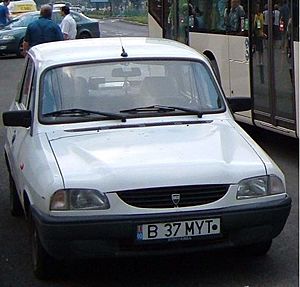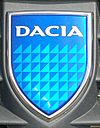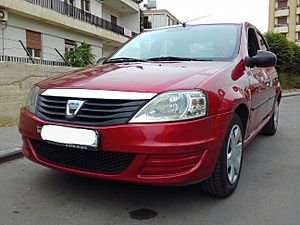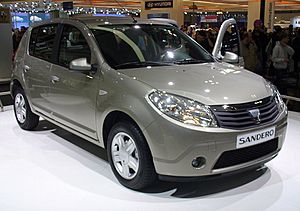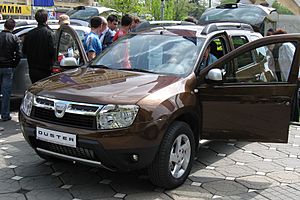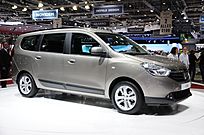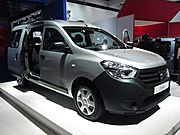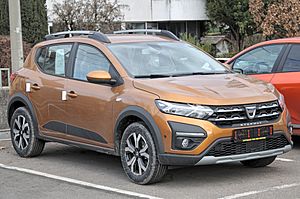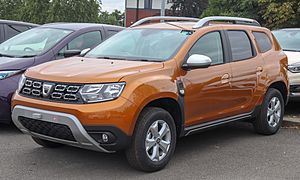Automobile Dacia facts for kids

Dacia stand at the 2024 Geneva International Motor Show
|
|
| Subsidiary | |
| Industry | Automotive |
| Founded | September 1966 |
| Headquarters | Mioveni, Argeș, Romania |
|
Area served
|
Europe (except Armenia, Azerbaijan, Belarus, Georgia, Russia, Ukraine), Algeria, Israel, Lebanon, Morocco, Overseas France and Tunisia |
|
Key people
|
|
| Products | Automobiles, commercial vehicles |
|
Production output
|
|
| Revenue | (€5,476 million) (2024) |
|
Operating income
|
|
| Total assets | |
| Total equity | |
|
Number of employees
|
|
| Parent | Renault |
Dacia is a well-known Romanian car company. Its full name is S.C. Automobile Dacia S.A. The name "Dacia" comes from an old historical region that is now part of Romania.
The company started in 1966. In 1999, the Romanian government sold Dacia to Renault, a big French car maker. Dacia is now Romania's largest company by how much money it makes. It is also the biggest exporter, meaning it sends the most products out of the country. In 2024, Dacia sold over 676,000 passenger cars and commercial vehicles. Since January 2021, Dacia has been part of Renault's Dacia-Lada business group.
Contents
History of Dacia Cars
The first factory building in the area was constructed between 1942 and 1945. It was an expansion of an aircraft factory. After World War II, the Romanian Railways took over the facility. This later became the Dacia car plants.
How Dacia Started
The Dacia car company began in 1966. Its original name was Uzină de Autoturisme Pitești (UAP). The main Dacia factory opened in 1968 in Mioveni, near Pitești.
Dacia bought the plans and tools to make the Renault 12 car. But while they waited for these tools, they decided to build the Renault 8 under a special agreement. This car was called the Dacia 1100. From 1968 to 1972, Dacia made 37,546 of the 1100 model. A special version, the 1100S, was made in small numbers for the police and for racing. It had two headlights and a stronger engine.
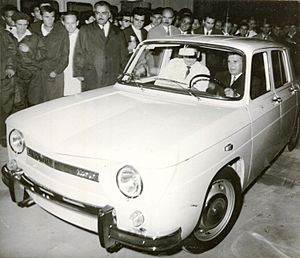
The first Dacia 1300 car was finished in August 1969. It was shown at car shows in Paris and Bucharest. People in Romania really liked its modern look and how reliable it was. There were always long waiting lists to buy one.
By 1970, there were two versions: the standard 1300 and the 1300L (for Lux). In 1974, the 1301 Lux Super came out. It had new features like a heated back window, a radio, and mirrors on both sides. This special car was mostly for important government officials.
Dacia soon started exporting cars to other countries. In 1973, they made the 1300 Break, which was a station wagon version. They also made special versions like the 1300F for carrying goods and the 1300S for ambulances. In 1975, the Dacia 1302 pick-up truck was created. About 2,000 of these were made until 1982.
Dacia also put together a small number of Renault Estafette vans. In the early 1980s, the Renault 20 was also assembled as the Dacia 2000. This car was very exclusive and only available in dark blue or black. It was also reserved for important officials.
In 1979, Dacia introduced the restyled 1310 models. These cars had four headlights, bigger taillights, and a new inside look. These changes were inspired by Renault's own updates to its 12 model. The 1310 arrived in Romania in late 1981. In the UK, it was called the Dacia Denem. This model even had a five-speed gearbox, special wheels, and electric windows.
At the same time, Dacia made the Sport model. In 1980, a prototype sports car called the Brașovia was shown. It was based on the 1310. From 1983, the two-door Dacia 1310 Sport (and later the 1410 Sport) was available for everyone to buy. These cars were popular for rallies and racing.
Dacia in the 1980s
Designers at Dacia kept coming up with new ideas. They created prototypes like the small 500cc Mini-Dacia. They also made special versions of the Dacia 1310, such as the Dacia 1310 Maxi Break. This was an eight-seater station wagon, made longer by about half a meter. About 10 to 12 of these cars were built.
In 1982, Dacia introduced the 1304 Pick-up and Drop-side models. These were very popular and stayed in production until December 2006. In 1985, the 1410 model with a larger engine became available.
For the 1984 model year, the 1310 models got small changes. They had a new spoiler and thicker rubber parts around the front grille and headlights. From late 1985, all models had these larger rubber parts and a spoiler. A five-speed gearbox also became an option.
Work was also happening on the 1320 CN1 model. This was a hatchback car based on the 1310. The new front design of the 1320 also appeared on some top-of-the-range models from about 1986. These cars had two large headlights, a nicer interior, and a new dashboard. The 1320 was the most expensive Dacia model when it came out in 1988. Many were used as taxis.
Dacia in the 1990s
The 1320 model was replaced in 1991 by the Dacia 1325 Liberta. This name meant "liberty" and was popular after the 1989 revolution in Romania. This model was made until 1996.
Dacia tried to update its car range. The Sport model was stopped. New commercial vehicles were introduced. The 1307 was a pick-up truck with a double cab. The 1309 was a station wagon with a tarpaulin cover instead of a trunk. This car sold very well in China.
In late 1994, Dacia launched a new model called the Dacia Nova. This was a compact car with a sedan or hatchback design. The design was a bit old-fashioned because it had been planned since 1983. The Nova was not very popular at first because of problems with reliability and rust. However, after improvements in 1996, the Nova became more common on Romanian roads.
In 1998, Dacia celebrated 30 years of making cars. The 2,000,000th car rolled off the factory line. This year also saw the last update to the 1310 model. It was called CN4. It had a new front design, new door handles, and a slightly changed rear view mirror. Even though the model was over 30 years old, it sold very well because it was affordable and parts were easy to find.
On July 21, 2004, the last cars of the 1300 series were made. This was just before their 35th anniversary. The very last Dacia 1310 sedan, car number 1,979,730, is now kept in the Dacia Museum.
On December 8, 2006, the Dacia Pick-Up utility vehicle also stopped being made. Even though it had been improved with features like four-wheel drive and a diesel engine, Romania joining the European Union meant the older models could no longer be produced. The factory lines were changed to make more Dacia Logan cars.
Over 34 years, Dacia made more than 2.5 million units of the Dacia 1300/1310. It became the most common car on Romanian roads. Many people learned how to fix these cars themselves.
Dacia Joins Renault
In September 1999, Dacia became part of the Renault group. Renault wanted Romania to be a center for car development in Central and Eastern Europe. So, they invested more money in Dacia.
The first big change came in 2000 with the SupeRNova. This was an improved version of the Nova with an engine and gearbox from Renault. The best version had air conditioning, electric windows, and a CD player. Sales were very good.
In 2003, a new version called the Dacia Solenza replaced the SupeRNova. It had a new interior and options for an airbag. This model was a temporary car until the important Dacia Logan was ready. It also helped workers learn how to make cars that would be popular in Western Europe. Production of the Solenza stopped in 2005.
Dacia from 2004 to 2011
The Dacia Logan is one of Dacia's most successful models since the original 1300. It was launched in August 2004. Even with some criticism about its design, it became a top-selling car in Central and Eastern Europe and Russia. The Logan is sold in many countries, sometimes under the Renault brand. It is still the best-selling car in Romania. A diesel version was also introduced in 2005. Before it launched, it was known as the "5000-Euro car" because of its expected low price.
In 2006, a prototype called the Logan Steppe was shown. This was a possible 4x4 station wagon version of the Logan. The actual station wagon version was launched in late 2006. The van version, which was a station wagon with no rear windows, came out in February 2007.
The Renault Technologie Roumanie engineering center was created in 2006 in Bucharest, Romania. About 2,500 engineers work there. They develop, test, and design new Dacia cars. They also help with marketing and technical support. In 2007, the company also opened a design office called Renault Design Central Europe.
A pick-up model and the Logan-based hatchback Sandero were launched in 2008. The Sandero was shown at the Geneva Motor Show. This was also when Dacia got a new logo and updated the Logan model.
In 2009, a new concept car called the Dacia Duster was shown at the Geneva Motor Show. This showed that Dacia planned to release an SUV (Sport Utility Vehicle). This car's design was used for the second generation of the Logan and Sandero models, which came out in 2012.
In 2010, the Dacia Duster was shown at the Geneva Motor Show. It was the first SUV built by Dacia since Renault bought the company. It came in 4x2 and 4x4 versions. It was released in Europe on March 18, 2010.
In September 2010, a testing center opened in Titu, Romania. It is part of Renault Technologie Roumanie. This center helps develop and improve new Dacia cars. It has nine types of tracks, totaling 32 kilometers, and about 100 test benches. These are used to test how well cars and parts can handle cold, heat, and rain.
Dacia from 2012 to 2020
In 2012, the Dacia Lodgy, a new compact MPV (Multi-Purpose Vehicle), was shown at the Geneva Motor Show. It is built on a new platform and made at a new Renault factory in Tangier, Morocco.
The Dokker, released in June 2012, is a slightly smaller leisure activity vehicle. It is also made in Tangier and shares the same platform as the Lodgy. It is available as a passenger car and a panel van.
In September 2012, the second generations of the Logan and Sandero were shown at the Paris Motor Show. They had a similar front design and came with better safety features, a new engine, and other comfort equipment.
The next year, the updated Duster was shown at the Frankfurt Motor Show. It had small changes to the front and back, the new interior from the Logan and Sandero, and a new turbocharged petrol engine.
At the 2017 Frankfurt Motor Show, the second generation Duster model was introduced. It brought new comfort and technical improvements but kept similar sizes and engines.
In 2020, Dacia announced it would release an electric car. They showed the Dacia Spring Electric concept in March 2020. The Dacia Spring is based on the Renault City K-ZE. It is expected to be one of the most affordable electric cars in Europe.
Dacia from 2021 to Today
In January 2021, Denis Le Vot became the CEO of the Dacia-Lada business unit. As part of a company update, Renault decided to combine the Dacia and Lada brands into a new business unit. Dacia also revealed a new logo and plans to offer more types of cars.
In March 2021, the production version of the Dacia Spring EV was shown. The Spring is sold in left-hand drive areas of Europe. It is sold alongside updated Sandero and Logan models. There is also a car-sharing version called the Spring Business.
Dacia Factories and Locations
Dacia's main factory is in Mioveni, Romania. This is also where its main offices are located. The factory can produce 350,000 vehicles each year. It has different sections for bodywork, painting, assembly, and making mechanical parts.
The factory works closely with the Renault Technologie Roumanie engineering center in Bucharest, which started in 2006. This center also includes a design office. There is also a testing center in Titu, which opened in 2010.
A large logistics center was built near the plant in March 2005. This center, called the International Logistic Network, sends car parts (called CKD kits) to other Renault factories. These factories are in places like Russia, Morocco, Colombia, Argentina, Brazil, South Africa, Iran, and India. It is said to be the biggest logistics center of its kind in the Renault Group and the global car industry. In 2012, the center sent out enough kits for 920,646 vehicles worldwide.
Dacia Cars Made Overseas
Two Dacia models, the Lodgy and the Dokker vans, are made at the Renault factory in Tangier, Morocco. The Logan and the Sandero are also made in Casablanca, Morocco, and the Sandero is also made in Tangier.
Innovation in Dacia
As more people in Europe wanted automatic gearboxes, Renault decided to create a special automatic gearbox called Easy-R. This new gearbox uses electric and mechanical parts instead of older hydraulic systems. This makes it more reliable and more affordable. Dacia started offering this feature in Europe in 2015 for about 600 euros, which is much cheaper than similar systems from other companies.
The Easy-R gearbox has fewer parts, which helps with reliability and makes it easier to fix. It has four modes: D (Drive), N (Neutral), R (Rear), and M (Manual). This gearbox uses the same amount of fuel as a manual gearbox but gives you the benefits of an automatic.
Dacia Sales
Dacia cars are sold in most Western and Eastern European countries. They are also sold in some North African countries like Algeria, Tunisia, and Morocco. Dacia started exporting to Western Europe in the late 1970s, entering markets like Belgium and the Netherlands in 1978. Dacia models have also been made by Renault in other parts of the world, like Russia, Iran, India, South Africa, Colombia, and Brazil. They are sometimes sold under the Renault brand or other local brands.
In 2012, Dacia sold a total of 359,822 vehicles. About 230,000 of these were exported to Western Europe, mostly to France and Germany. Besides Romania, Dacia's other important markets include Algeria, Turkey, Italy, and Spain.
In 2014, the company sold 511,465 vehicles in 43 countries, setting a new record. On May 6, 2014, the main Dacia factory in Mioveni produced its five millionth car. This was about the three millionth car made since Renault bought the brand.
In November 2015, the 3.5 millionth Dacia car was sold in the UK since the brand was relaunched ten years earlier. In 2015, Dacia set another sales record, selling 550,920 units. Dacia car sales went over 700,000 units in 2018.
Sales Figures
Here are the historical sales figures for Dacia models (under the Dacia brand only):
Dacia Car Models
Current Dacia Models
- Dacia Duster Pick-Up (2020–present)
- Dacia Logan III (2020–present)
- Dacia Sandero III (2020–present)
- Dacia Sandero Stepway III (2020–present)
- Dacia Spring Electric (2021–present)
- Dacia Spring Cargo (2021–present)
- Dacia Jogger (2022–present)
- Dacia Sandrider (2023–present)
- Dacia Duster III (2024–present)
- Dacia Bigster (2025–present)
Past Dacia Models
- Dacia 1100 (1968–1972)
- Dacia 1300 (1969–1979)
- Dacia 1301 (1970–1974)
- Dacia D6 Estafette (1974–1976)
- Dacia 1302 (1975–1982)
- Dacia 1210/1310/1410 (1979–2004; Dacia Denem in the United Kingdom)
- Dacia 1304 Pick Up (1979–2006)
- Dacia 2000 (1980–1982)
- Dacia Duster (1983–1990s; rebadged ARO 10 in the United Kingdom)
- Dacia 1310 Sport/1410 Sport (1983–1992)
- Dacia 1320 (1985–1989)
- Dacia 1305 Drop Side (1985–2006)
- Dacia 500 Lăstun (1988–1991)
- Dacia Liberta (1990–1996)
- Dacia 1309 (1992–1997)
- Dacia 1307 King Cab (1992–2003)
- Dacia 1307 Double Cab (1992–2006)
- Dacia Nova (1994–1999)
- Dacia SupeRNova (2000–2003)
- Dacia Solenza (2003–2005)
- Dacia Logan I (2004–2012)
- Dacia Logan I MCV (2006–2012)
- Dacia Logan Van (2007–2012)
- Dacia Logan Pick-Up (2008–2012)
- Dacia Sandero I (2008–2012)
- Dacia Sandero Stepway I (2008–2012)
- Dacia Duster I (2009–2017)
- Dacia Logan II (2012–2020)
- Dacia Logan II MCV (2012–2020)
- Dacia Sandero II (2012–2020)
- Dacia Sandero Stepway II (2012–2020)
- Dacia Logan II Stepway (2019–2020)
- Dacia Dokker (2012–2021)
- Dacia Lodgy (2012–2022)
- Dacia Duster II (2017–2024)
Dacia Prototype Cars
- Dacia Braşovia coupé (1980)
- Mini-Dacia (1980s) – a small prototype car
- Dacia Jumbo highrise van (1990)
- Dacia Nova minivan (1998)
- Dacia Star (1991)
- Dacia 1310 convertible (1987; three made)
- Dacia 1306 saloon-derived pick-up (1994/5; very small number)
- Dacia 1310 Break Limousine (late 1980s) – a stretched station wagon with seven seats
- Dacia D33 (1997) – a prototype designed by IDEA design house
- Dacia 1310 4x4 / Aro 12 (late 1980s) – a 4x4 version of the station wagon
- Dacia Duster concept car (2009)
Dacia Marketing and Sponsorships
Dacia has sponsored sports teams. From 2008 to 2023, Dacia sponsored the Italian football club Udinese Calcio.
In February 2016, Dacia became the official car partner of the Rugby League Super League and the Challenge Cup. They also became the main sponsors of the men's, women's, and wheelchair England rugby teams in June 2017. Dacia also supported the Great Britain Rugby League Lions in 2019.
Images for kids
See also
 In Spanish: Automobile Dacia para niños
In Spanish: Automobile Dacia para niños



